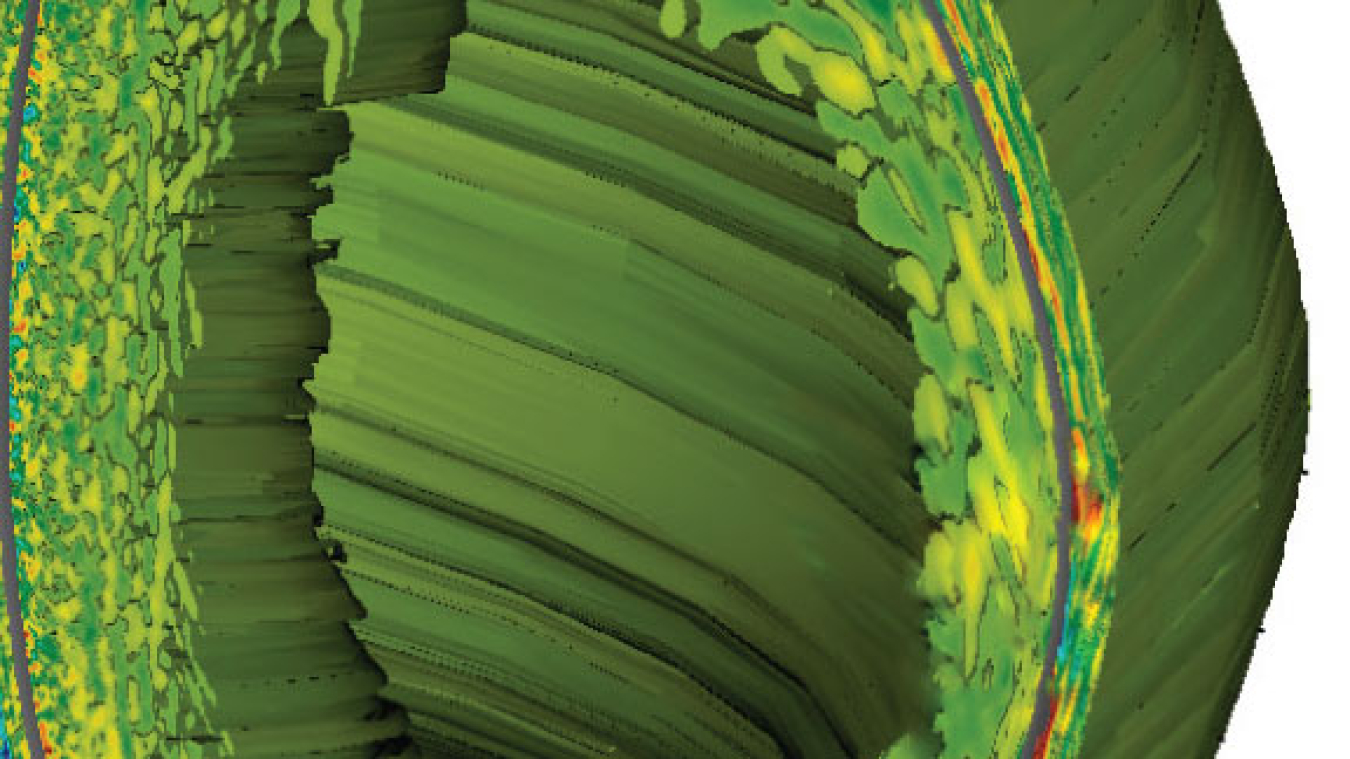To design future fusion reactors, scientists needed to go back to the very basic principles of physics.
January 17, 2019
Scientists at the Department of Energy's Princeton Plasma Physics Laboratory worked to understand how and why turbulence at the edge of plasma in a fusion experiment increases and abruptly decreases.
Hot plasma swirls in a massive tokamak machine, burning 10 times hotter than the core of the sun. The plasma's energy rises and rises; the pressure builds and builds. The plasma along the edge, where it meets the machine's walls, turbulently whirls faster and faster. Suddenly, the plasma at the edge settles down.
At that moment, the plasma has reached what fusion scientists call the "high-confinement mode" or H-mode. Reaching and maintaining the H-mode may be essential for developing an efficient future fusion reactor. In the H-mode, a calm edge without turbulence reduces how much heat and how many charged particles the plasma loses. This leads to a sharp increase in pressure across the entire volume of the plasma, including the core where the conditions that can lead to fusion occur. The reduced energy and particle losses also minimize damage to the material surfaces surrounding the plasma.
One day, fusion reactors could produce clean, reliable energy. Before that happens, scientists need to understand how to get a fusion reaction up and running so that reactors produce much more energy than they consume. They know fusion requires combining nuclei together at high pressure, but they need a recipe to get there. Knowing how to reach the H-mode is a fundamental part of developing that recipe.
Seeing the H-mode in action is nothing new in fusion experiments. In fact, scientists first observed plasma transitioning to the H-mode in a German experimental facility almost 40 years ago. Many physicists, including C.S. Chang from the Department of Energy (DOE) Office of Science's Princeton Plasma Physics Laboratory (PPPL), have been studying the physics of the H-mode transition for nearly that long. Until recently, Chang and his fellow scientists did not understand the fundamental physics behind this process. As a result, they didn't know if future machines designed to harness fusion – which are much larger than current machines – will be able to reach the H-mode in the same way today's experimental machines do.
That's why DOE's Office of Science supported Chang and his team as they simulated how plasma transitions between different types of edge modes, including the H-mode. Computer simulations can act as an experimental kitchen, where scientists can try out various ideas and parameters before producing a product.
"Developing a fusion reactor has been very experimental, expensive, and time consuming," said Chang. "[If we] use the fundamental fusion code to understand the physics before we build the next machine, we can save a lot of time and money."
Modeling from Scratch
Like cooks, modelers are limited by the ingredients they have access to. Unfortunately, the data set Chang's team had didn't point to the H-mode. It was from a former fusion experiment at the Massachusetts Institute of Technology (MIT) called the Alcator C-Mod. But that data set was supposed to be associated with reaching a different mode that keeps heat contained but not particles. So they originally planned to study that transition.
Plenty of physicists have theorized transitions in plasma before. But previous models simplified the processes so much that physicists came to different conclusions about what caused the transitions.
"Simplifying means that you leave out a lot of things," said Chang. "You never know if the physics parts that you threw away were important or not."
Chang's team wanted to fill in those details by modeling the transition from the most basic physics principles possible. By including details that had been previously left out—like how individual particles move through plasma—they aimed to understand how the ingredients work together. The ideal is following the transition from the very beginning to its end, when the plasma achieves a sharp increase in edge pressure.
"That's kind of a Holy Grail," said Chang.
But that would require a computer that can make a billion billion calculations per second. Although DOE plans to bring a computer that powerful online in 2021, the team couldn't wait that long. They wanted their study to inform the building of ITER which, when completed, will be the world's largest experimental tokamak fusion reactor.
So they used Titan. Part of the Oak Ridge Leadership Computing Facility (OLCF), a DOE Office of Science user facility, Titan is one of the world's most powerful supercomputers. Instead of modeling the entire process, the team only looked at the times from right before until right after the transition. The abbreviated simulation still ran for three days straight and used 90 percent of Titan's computing power.
Answering a Decades-Old Question
The results surprised the team. They definitely knew their boundaries and data could simulate the other transition; they didn't expect it to reach the H-mode transition. Yet it did.
"My first impression was, was there something wrong in that simulation?" recalled Seung-Hoe Ku, a PPPL scientist and the project's lead modeler. "Did I make a mistake?"
He did. But it was a happy one. When the MIT scientists captured the data from the Alcator C-Mod, they oriented the magnetic field in the physical experiment in a way that made reaching the H-mode unlikely. But when Ku put the Alcator C-Mod's parameters into the model, he flipped that magnetic field in the model to the direction experimentalists normally use for the H-mode transition. The data was still valid, but functioned differently. That turned out to be the key.
Describing his reaction, Chang said, "We got the simulation done – oh yes, we got the turbulence bifurcation done! This is something you have been waiting on for decades."
The results also brought together two competing sets of scientists with different explanations about why the transition between modes occurs.
As Michael Churchill, a PPPL scientist on the team, said, "Somebody joked once that there are a hundred or so theories."
Previously, the two groups disagreed over what set of physical mechanisms in the plasma led to the H-mode. The PPPL study showed that both groups were right. It's actually the interplay between the different forces that leads to the transition.
Understanding this relationship helps fusion scientists figure out how much energy has to be put into the plasma in a future fusion reactor before the H-mode transition occurs and the fusion burn starts. While scientists had a recipe with the ingredients before, this study will help them find out how much heat they need to put into it.
The team plans to expand the simulation as more computing power becomes available. Even if they aren't able to write a full recipe for fusion before he retires, Chang knows his team's contributions have filled in some gaps in the search for clean, efficient energy.
"Whatever possible source of energy there is, we have to try it. We have to study it," said Chang. "Anything with such a big impact as fusion is not that easy to come by."
The Office of Science is the single largest supporter of basic research in the physical sciences in the United States and is working to address some of the most pressing challenges of our time. For more information please visit https://science.energy.gov.
Shannon Brescher Shea

Shannon Brescher Shea (shannon.shea@science.doe.gov) is the social media manager and senior writer/editor in the Office of Science’s Office of Communications and Public Affairs. She writes and curates content for the Office of Science’s Twitter and LinkedIn accounts as well as contributes to the Department of Energy’s overall social media accounts. In addition, she writes and edits feature stories covering the Office of Science’s discovery research and manages the Science Public Outreach Community (SPOC). Previously, she was a communications specialist in the Vehicle Technologies Office in the Office of Energy Efficiency and Renewable Energy. She began at the Energy Department in 2008 as a Presidential Management Fellow. In her free time, she enjoys bicycling, gardening, writing, volunteering, and parenting two awesome kids.


